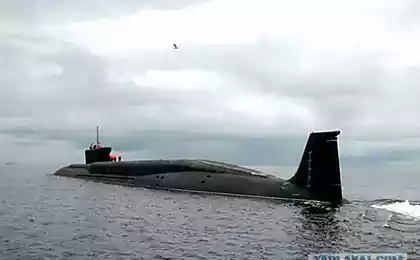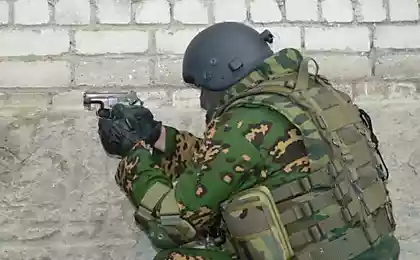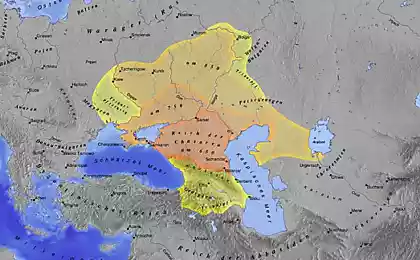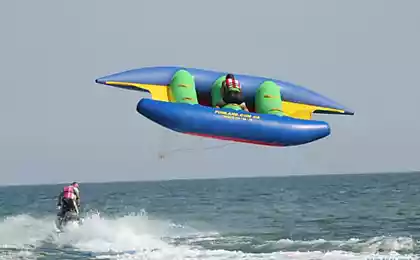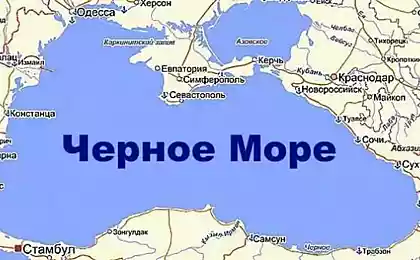899
"Bastion" - a reliable anti-ship weapon
The latest Russian anti-missile complexes "Bastion" from which sweep almost all of the Black Sea - one of the key means of coastal defense American destroyer "Truxton" on Friday evening, March 7, crossed the Bosporus and entered the Black Sea. The American ship was accompanied by a Coast Guard cutter Turkey. In accordance with the Montreux Convention on the status of the straits, warships states without access to the Black Sea may be in its waters no more than 21 days. As previously reported by the US Department of Defense, the destroyer will take part in the planned exercises with naval forces in Romania and Bulgaria.
Trade
Earlier, Russian Foreign Minister Sergey Lavrov declared that the territory of Ukraine is preparing new provocations against the Russian Black Sea Fleet. March 4 crossed the Bosphorus two Russian warships and one Ukrainian, adds AFP.
Sunset US destroyer in the Black Sea coincided with the worsening situation in the Crimea, where the Russian Black Sea Fleet. The new authorities autonomous republic refuse to obey the new central government of Ukraine and intend to hold a referendum on joining Russia.
US Secretary of State John Kerry presented the Russian ultimatum, which imply the use of non-diplomatic move to ways of influencing the American side. In this situation, we can not exclude the military buildup of US forces and their allies in the Black Sea.
However, even if the bad dream suggests that the group of ships of the US Navy took the Straits, entered the Black Sea, came to the shores of the Crimea and began an operation to be there "forced" to anything, this idea would have died without being born. Because a few years ago on the Russian coast of the Black Sea were deployed mobile coastal anti-ship missiles (SCRC) "Bastion-P" with supersonic cruise missiles "Onyx", which became one of the most important parts of coastal antiship defense.
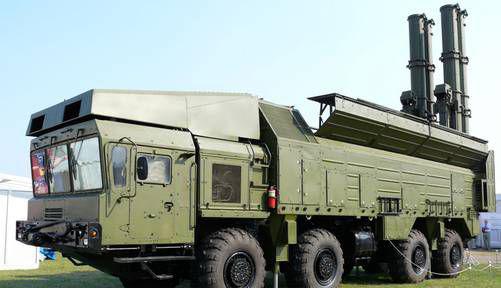
In place of the "redoubt»
SCRC operational-tactical "Bastion" development NGOs "Engineering" has replaced adopting the Soviet Union in 1966 the mobile SCRC 4K44B "Redoubt" shoot supersonic missiles P-35B at a distance of up to 270 km. Its development began in the 80th century godyproshlogo, but the concept of causality adopted Russian Armed Forces "Bastion" was officially adopted only in 2010.
The complex is made in two versions - stationary ("Bastion-S") and mobile ("Bastion-P"). They are designed to destroy surface ships of all classes and types from the ship and aircraft carrier battle groups, amphibious compounds convoys, as well as certain single ships and land-based radio-purposes in heavy electronic and fire counteraction of the enemy. Each complex is able to protect the coastline stretching over 600 km from possible enemy amphibious operations. Of particular interest is the complex "Bastion - P". Time to bring it into full combat readiness of the receipt of the order on the march does not exceed 5 minutes. At the same time, the SCRC after his deployment can remain fully operational in the autonomous state of up to 5 days. The basic structure of this complex consists of four self-propelled launchers K-340P based on the MZKT-7930 "astrologer" with a power reserve of up to 1,000 km, vehicle command and control K-380R on the basis of KAMAZ-43101, up to four transport-charging machine K-342, machines and provide alerting - for the transportation and placement of domestic personnel. The complex may further include self-propelled-horizon radar detection of air and surface targets "Monolith-B" or target designation can be made from a helicopter.
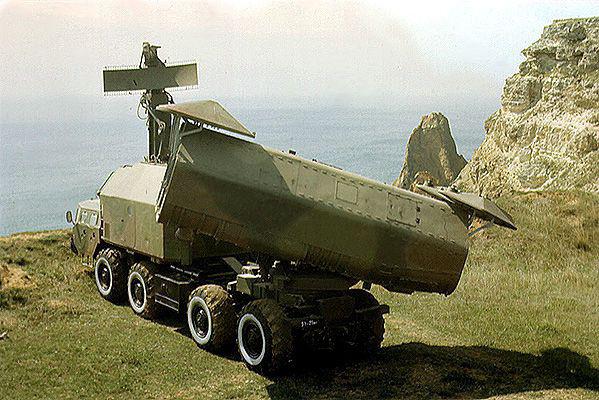
Killer "thorn»
Now about the rocket, which fires "Bastion". Her Russian name - P-800 "Onyx". The export version is called "Yakhont". In the terminology of NATO - SS-N-26 Strobile. This is perhaps the most famous at the moment Russian operational and tactical cruise anti-ship missile. It was on the basis of its Russian-Indian joint venture BrahMos Aerospace is now creating a new hypersonic (ie, 5-6 to move into the speed of sound) cruise anti-ship missile.
TTX missiles (all data provided from public sources and relate mainly to the "Yakhont"). Length, depending on the modifications 6 to 8, 6 meters. The starting weight - 3 tons. Maximum speed - 750 m \ s. Flight height - from 10 m to 14 km. Warhead weight "Yakhont" - 200 kg. Firing range of high-altitude path - up to 500 km on a combined path - up to 300 km, for low-altitude trajectory (ie, almost close to the surface of the water, taking into account the excitement of the sea up to 7 points) - up to 120 km.
The weight data warhead "Onyx" vary greatly according to different sources. I will say one thing. According, again, from open sources, radar homing head, mounted on a Russian rocket, capable of capturing freeboard aim of class "cruiser" at a distance of 75 km. And, then, CU "Onyx" is intended nothing less than this class of ships. American cruiser type "Tikondenroga" recall, have a displacement of 10 tons, the Russian aircraft carrier of the "Orlan" - more than 25 thousand tons. And no one else in the world, the cruisers and there now, although the displacement of Japanese destroyers, for example, also now reaches 10 thousand tons. In any case, cruise missiles "Onyx \ Yakhont" are now among the most formidable, if not the most formidable anti-ship cruise missiles in the world. American experts, at least, see them as a serious threat not only to their cruisers, and aircraft carriers.
And no wonder, since it not only powerful, but also a sly missile. Its main features are the full autonomy of combat employment ("fire and forget"), supersonic speed in all areas of flight trajectories of a set of flexible and low visibility to radar means.
Before the rocket speed of Mach 2 is dispersed after several seconds after leaving a special sealed transport and launch container (by the way, it's very convenient to serve). Then, depending on the flight mission, or remains at this speed or accelerated to the speed 2, 7M.
For the purpose of rocket leaves, usually at midget height of about 10 meters above the sea surface, making it difficult to elimination of shipboard systems. At the final stage, guided by its own database, the missile itself chooses the main purpose in the warrant and the algorithm of its defeat. At the same time on the approach to the order of several ships "Onyx \ Yakhontov" what happens when you fire a volley from the complex "Bastion-P" at the missile triggered a "collective intelligence" incorporated in their constructors. In this case, depending on the task, or they operate on the principle "one missile - one ship" or "flock" piling such as the flagship.
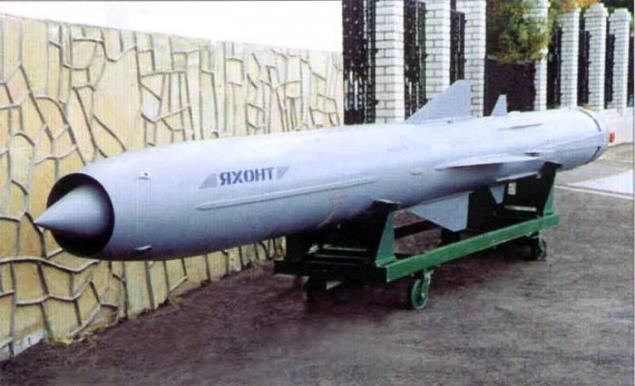
Guarding the borders
"Bastion-P" now is in service of the three countries - Vietnam (2 set), Syria (2 Complex) and Russia (3 sets). In the first two countries, he charged "Yakhont", Russia, respectively, "Onyx". And the presence of Syria's such a powerful defensive weapon, obviously also played a role in the fact that no Western ship there and went on a short distance to the Syrian coast (although the main thing in this situation is, of course, in the political positions of Russia and China settlement of the Syrian conflict by peaceful means).
In Russia, all three batteries "Bastion-P" were transferred to equip the 11th separate missile and artillery brigade of the Black Sea Fleet, stationed near Anapa. There also, obviously, will be transferred to the battery and the fourth "Bastion-P", which had to be completely ready for the transfer of the military at the end of last year. And, obviously, there is the presence of anti-complexes, is an additional guarantee of stability in the Crimean peninsula. From there - from Anapa, using the "Bastion-P" sweep all the approaches to the entire east coast of the Crimea - from Alupka to Kerch. But it is a straight line. If we consider that even a high trajectory "Yakhont" can overcome the distance of 500 km, then the battery chamber of the Russian "Bastion-P" fall approaches and the west coast of the Crimean Peninsula, including, of course, Sevastopol. And this circumstance, once again, can serve as an additional guarantee that the situation in the Crimea will be developed according to the will of the majority of its inhabitants.
Russian SCRC operational-tactical "Bastion", obviously, and will continue to act as a reliable barrier against attacks from the sea unexpected guests. Last fall, the commander in chief of the Russian Navy Admiral Viktor Chirkov said that under the current state program of armaments coastal forces of the Navy until 2020, will have about 20 new coastal missile complexes "Bastion" and "Bal" ("Bal-E" - tactical set subsonic Kh-35). As the production capacity for the production of "Bastion", obviously, this complex will be more actively promoted by Russian machine builders and abroad, especially in South-East Asia.
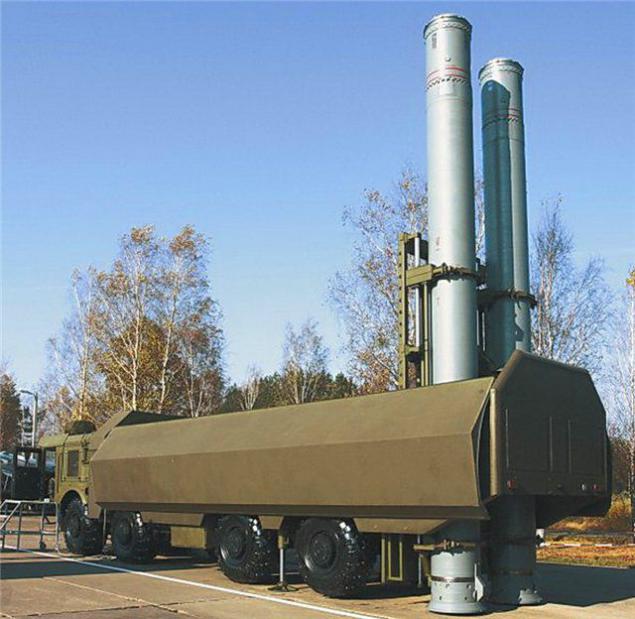
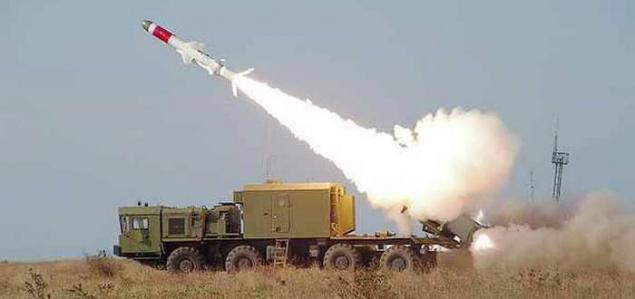
Source: expert.ru
Trade
Earlier, Russian Foreign Minister Sergey Lavrov declared that the territory of Ukraine is preparing new provocations against the Russian Black Sea Fleet. March 4 crossed the Bosphorus two Russian warships and one Ukrainian, adds AFP.
Sunset US destroyer in the Black Sea coincided with the worsening situation in the Crimea, where the Russian Black Sea Fleet. The new authorities autonomous republic refuse to obey the new central government of Ukraine and intend to hold a referendum on joining Russia.
US Secretary of State John Kerry presented the Russian ultimatum, which imply the use of non-diplomatic move to ways of influencing the American side. In this situation, we can not exclude the military buildup of US forces and their allies in the Black Sea.
However, even if the bad dream suggests that the group of ships of the US Navy took the Straits, entered the Black Sea, came to the shores of the Crimea and began an operation to be there "forced" to anything, this idea would have died without being born. Because a few years ago on the Russian coast of the Black Sea were deployed mobile coastal anti-ship missiles (SCRC) "Bastion-P" with supersonic cruise missiles "Onyx", which became one of the most important parts of coastal antiship defense.

In place of the "redoubt»
SCRC operational-tactical "Bastion" development NGOs "Engineering" has replaced adopting the Soviet Union in 1966 the mobile SCRC 4K44B "Redoubt" shoot supersonic missiles P-35B at a distance of up to 270 km. Its development began in the 80th century godyproshlogo, but the concept of causality adopted Russian Armed Forces "Bastion" was officially adopted only in 2010.
The complex is made in two versions - stationary ("Bastion-S") and mobile ("Bastion-P"). They are designed to destroy surface ships of all classes and types from the ship and aircraft carrier battle groups, amphibious compounds convoys, as well as certain single ships and land-based radio-purposes in heavy electronic and fire counteraction of the enemy. Each complex is able to protect the coastline stretching over 600 km from possible enemy amphibious operations. Of particular interest is the complex "Bastion - P". Time to bring it into full combat readiness of the receipt of the order on the march does not exceed 5 minutes. At the same time, the SCRC after his deployment can remain fully operational in the autonomous state of up to 5 days. The basic structure of this complex consists of four self-propelled launchers K-340P based on the MZKT-7930 "astrologer" with a power reserve of up to 1,000 km, vehicle command and control K-380R on the basis of KAMAZ-43101, up to four transport-charging machine K-342, machines and provide alerting - for the transportation and placement of domestic personnel. The complex may further include self-propelled-horizon radar detection of air and surface targets "Monolith-B" or target designation can be made from a helicopter.

Killer "thorn»
Now about the rocket, which fires "Bastion". Her Russian name - P-800 "Onyx". The export version is called "Yakhont". In the terminology of NATO - SS-N-26 Strobile. This is perhaps the most famous at the moment Russian operational and tactical cruise anti-ship missile. It was on the basis of its Russian-Indian joint venture BrahMos Aerospace is now creating a new hypersonic (ie, 5-6 to move into the speed of sound) cruise anti-ship missile.
TTX missiles (all data provided from public sources and relate mainly to the "Yakhont"). Length, depending on the modifications 6 to 8, 6 meters. The starting weight - 3 tons. Maximum speed - 750 m \ s. Flight height - from 10 m to 14 km. Warhead weight "Yakhont" - 200 kg. Firing range of high-altitude path - up to 500 km on a combined path - up to 300 km, for low-altitude trajectory (ie, almost close to the surface of the water, taking into account the excitement of the sea up to 7 points) - up to 120 km.
The weight data warhead "Onyx" vary greatly according to different sources. I will say one thing. According, again, from open sources, radar homing head, mounted on a Russian rocket, capable of capturing freeboard aim of class "cruiser" at a distance of 75 km. And, then, CU "Onyx" is intended nothing less than this class of ships. American cruiser type "Tikondenroga" recall, have a displacement of 10 tons, the Russian aircraft carrier of the "Orlan" - more than 25 thousand tons. And no one else in the world, the cruisers and there now, although the displacement of Japanese destroyers, for example, also now reaches 10 thousand tons. In any case, cruise missiles "Onyx \ Yakhont" are now among the most formidable, if not the most formidable anti-ship cruise missiles in the world. American experts, at least, see them as a serious threat not only to their cruisers, and aircraft carriers.
And no wonder, since it not only powerful, but also a sly missile. Its main features are the full autonomy of combat employment ("fire and forget"), supersonic speed in all areas of flight trajectories of a set of flexible and low visibility to radar means.
Before the rocket speed of Mach 2 is dispersed after several seconds after leaving a special sealed transport and launch container (by the way, it's very convenient to serve). Then, depending on the flight mission, or remains at this speed or accelerated to the speed 2, 7M.
For the purpose of rocket leaves, usually at midget height of about 10 meters above the sea surface, making it difficult to elimination of shipboard systems. At the final stage, guided by its own database, the missile itself chooses the main purpose in the warrant and the algorithm of its defeat. At the same time on the approach to the order of several ships "Onyx \ Yakhontov" what happens when you fire a volley from the complex "Bastion-P" at the missile triggered a "collective intelligence" incorporated in their constructors. In this case, depending on the task, or they operate on the principle "one missile - one ship" or "flock" piling such as the flagship.

Guarding the borders
"Bastion-P" now is in service of the three countries - Vietnam (2 set), Syria (2 Complex) and Russia (3 sets). In the first two countries, he charged "Yakhont", Russia, respectively, "Onyx". And the presence of Syria's such a powerful defensive weapon, obviously also played a role in the fact that no Western ship there and went on a short distance to the Syrian coast (although the main thing in this situation is, of course, in the political positions of Russia and China settlement of the Syrian conflict by peaceful means).
In Russia, all three batteries "Bastion-P" were transferred to equip the 11th separate missile and artillery brigade of the Black Sea Fleet, stationed near Anapa. There also, obviously, will be transferred to the battery and the fourth "Bastion-P", which had to be completely ready for the transfer of the military at the end of last year. And, obviously, there is the presence of anti-complexes, is an additional guarantee of stability in the Crimean peninsula. From there - from Anapa, using the "Bastion-P" sweep all the approaches to the entire east coast of the Crimea - from Alupka to Kerch. But it is a straight line. If we consider that even a high trajectory "Yakhont" can overcome the distance of 500 km, then the battery chamber of the Russian "Bastion-P" fall approaches and the west coast of the Crimean Peninsula, including, of course, Sevastopol. And this circumstance, once again, can serve as an additional guarantee that the situation in the Crimea will be developed according to the will of the majority of its inhabitants.
Russian SCRC operational-tactical "Bastion", obviously, and will continue to act as a reliable barrier against attacks from the sea unexpected guests. Last fall, the commander in chief of the Russian Navy Admiral Viktor Chirkov said that under the current state program of armaments coastal forces of the Navy until 2020, will have about 20 new coastal missile complexes "Bastion" and "Bal" ("Bal-E" - tactical set subsonic Kh-35). As the production capacity for the production of "Bastion", obviously, this complex will be more actively promoted by Russian machine builders and abroad, especially in South-East Asia.


Source: expert.ru








